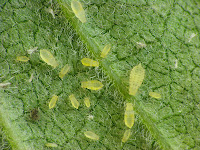 |
| Striped garden caterpillar, Trichordestra legitima |
It is November. We are deep into autumn. Monarch butterflies
stopped feeding on milkweeds and are long gone from this area. Milkweeds are
wilting, dropping leaves, some covered with sooty mold, and others reduced to
dry stems and seed pods. Still they continue to nourish and shelter a number of
species that depend on them.
A noctuid moth, the striped garden caterpillar moth (Trichordestra legitima), spends the
winter as a pupa. An occasional caterpillar hangs around this late in the
season taking advantage of the last scraps of food. Unlike monarchs, it is not
choosy. This one happens to be feeding on common milkweed but others find nourishment
in an incredible assortment of plants, from asparagus to yarrow or tobacco.
 |
| Oleander aphid, Aphis nerii |
Aphids are busy sucking juices from the few remaining green stems
and leaves of milkweeds. Their colonies are usually considerably larger this
time of the year. The most frequent species on common milkweed is the oleander
aphid (Aphis nerii), a bright
yellow-orange one.
 |
| Myzocallis asclepiadis |
Less common is the aphid called only by its scientific name, Myzocallis
asclepiadis, about the same size as the oleander aphid, almost translucent,
with dark dots and often seen sharing plants with its more colorful relative. Myzocallis asclepiadis specializes on Asclepias, as its name suggests. The
oleander aphid has broader tastes, living on other members of the dogbane
family (Apocinaceae), as well as occasionally some plants of the potato family.
This aphid is not native to this hemisphere, and, curiously, there are no males
in the North American populations, so they only reproduce parthenogenetically
or by virgin birth.
 |
| Labidomera clivicollis, larva |
 |
| Labidomera clivicollis |
A colorful beetle, the swamp milkweed leaf beetle (Labidomera clivicollis) is not as
selective as its name indicates and also feeds on common milkweed, as this larva
was doing. It is unusual to find a larva still feeding in November. There was an
adult nearby.
 |
| large milkweed bug, Oncopeltus fasciatus |
A common denizen of dry and dying milkweeds is the large
milkweed bug (Oncopeltus fasciatus).
Both adults and juveniles (called nymphs) feed on seeds of this plant as well
as leaves. So it is not surprising to see them in large numbers in November.
Soon all these milkweed visitors will be gone, too. The one
that will remain will be the longhorned milkweed beetle (Tetraopes
tetrophthalmus). Its larvae will remain
buried underground feeding on roots and waiting for next spring.
Beginners Guide to Pollinators and Other Flower Visitors
Beginners Guide to Pollinators and Other Flower Visitors
© Beatriz Moisset. 2012
No comments:
Post a Comment